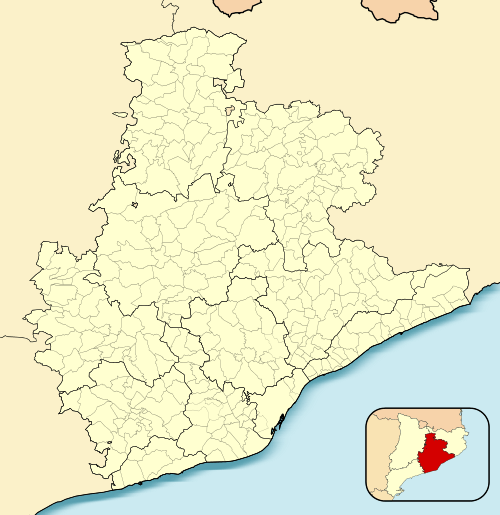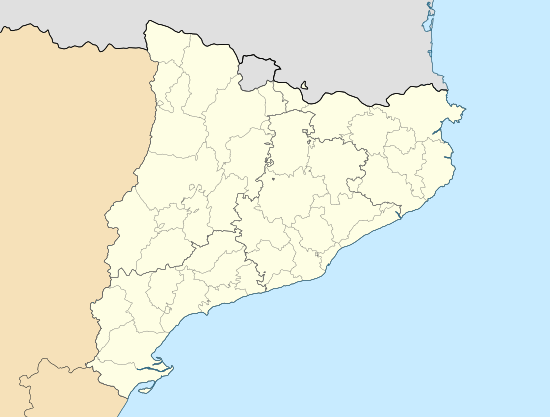Badalona
Badalona (/ˌbædəˈloʊnə/, Catalan pronunciation: [bəðəˈlonə]) is a municipality to the immediate north east of Barcelona in Catalonia, Spain. It is located on the left bank of the Besòs River and on the Mediterranean Sea, in the Barcelona metropolitan area. By population, it is the third largest city in Catalonia and the twenty-third in Spain. It became a city in 1897.
Badalona | |
|---|---|
 | |
 Flag  Coat of arms | |
 Badalona Location in the Province of Barcelona#Location in Catalonia#Location in Spain  Badalona Badalona (Catalonia)  Badalona Badalona (Spain) | |
| Coordinates: 41°26′56″N 2°14′46″E | |
| Country | |
| Autonomous community | |
| Province | Barcelona |
| Comarca | Barcelonès |
| Government | |
| • Mayor | Xavier García Albiol (2020)[1] (PP) |
| Area | |
| • Total | 21.2 km2 (8.2 sq mi) |
| Elevation | 12 m (39 ft) |
| Population (2018)[3] | |
| • Total | 217,741 |
| • Density | 10,000/km2 (27,000/sq mi) |
| Demonyms | Badaloní; Badalonina (ca) Badalonés; Badalonesa (es) |
| Postal code | 08910-08918 |
| Area code(s) | (+34) 934 |
| Climate | Csa |
| Website | badalona |
History
Badalona was founded by the Romans in the 3rd century BC, with the name of Baetulo, although human settlements in the area had existed from 3500-2500 BC. The Iberians had fortified villages on the Melasas and Boscà hills since the 7th century BC. The Roman town's plan was based on their common scheme of the cardo and decumanus, occupying some 11 ha, with a line of walls measuring 413x261 m and having large defensive towers. In the 1st century BC it had some 15,000 inhabitants.
The current Badalona was formed in the 10th century, as a new urban nucleus built over and around the old Roman city. It comprised a group of houses built around the square and the church. At the same time, a rural nucleus grew up outside the town walls. This rural and urban dichotomy would remain until the mid-18th century.
Sant Jeroni de la Murtra Monastery, built in the 14th century, is where the Catholic Monarchs would spend their summers. This is also where they received Christopher Columbus after his first voyage to the Americas. Badalona was one of the most important towns during the Spanish industrialization process, from the 19th century onwards.
Climate
| Climate data for Badalona | |||||||||||||
|---|---|---|---|---|---|---|---|---|---|---|---|---|---|
| Month | Jan | Feb | Mar | Apr | May | Jun | Jul | Aug | Sep | Oct | Nov | Dec | Year |
| Average high °C (°F) | 13.7 (56.7) |
14.1 (57.4) |
15.7 (60.3) |
17.4 (63.3) |
20.2 (68.4) |
23.7 (74.7) |
26.8 (80.2) |
27.9 (82.2) |
24.8 (76.6) |
21.5 (70.7) |
17.2 (63.0) |
14.4 (57.9) |
19.8 (67.6) |
| Daily mean °C (°F) | 10.1 (50.2) |
10.7 (51.3) |
12.5 (54.5) |
14.2 (57.6) |
17.4 (63.3) |
21.3 (70.3) |
24.3 (75.7) |
25.0 (77.0) |
21.8 (71.2) |
18.3 (64.9) |
13.7 (56.7) |
11.0 (51.8) |
16.7 (62.1) |
| Average low °C (°F) | 6.7 (44.1) |
7.2 (45.0) |
9.3 (48.7) |
11.0 (51.8) |
14.6 (58.3) |
18.6 (65.5) |
21.7 (71.1) |
21.8 (71.2) |
18.8 (65.8) |
15.1 (59.2) |
10.3 (50.5) |
7.6 (45.7) |
13.6 (56.5) |
| Average precipitation mm (inches) | 43.8 (1.72) |
36.3 (1.43) |
36.3 (1.43) |
41.8 (1.65) |
49.7 (1.96) |
37.2 (1.46) |
25.2 (0.99) |
49.3 (1.94) |
78.4 (3.09) |
80.9 (3.19) |
54.4 (2.14) |
41.2 (1.62) |
575 (22.6) |
| Average precipitation days (≥ 0.1 mm) | 7.8 | 7.3 | 7.5 | 8.7 | 7.6 | 4.4 | 3.8 | 4.8 | 7.0 | 6.7 | 6.5 | 4.0 | 76 |
| Average relative humidity (%) | 67 | 65 | 69 | 72 | 73 | 72 | 73 | 73 | 72 | 73 | 69 | 68 | 70 |
| Source: MeteoBDN[4] (1981-2010, 2009-2017 for precipitation days and humidity) | |||||||||||||
Transportation
Badalona has a RENFE train station R1 from Barcelona to Mataró - Blanes, as well as a harbour. There are also links to Barcelona via the Barcelona Metropolitan Transport (TMB) metro (underground) and bus system, as well as the Trambesòs line.
Population
Badalona has the second-largest Moroccan and Pakistani populations of Catalonia. Other significant communities include Maghrebis, Chinese, and Indians.[5]
| Largest groups of foreign residents | |
| Nationality | Population (2011) |
|---|---|
| 5,527 | |
| 5,462 | |
| 3,835 | |
| 3,062 | |
| 1,800 | |
| 1,305 | |
| 1,222 | |
| 1,000 | |
Economy
The harbour is important for its fishing and boat-building trades, while in town there are gas, chemical and mineral-oil works, as well as the manufacture of woollen and cotton goods, glass, biscuits, sugar and brandy. The surrounding fertile plains produce an abundance of grain, wine and fruit. The city is home to the historic distillery which produces Anís del Mono, an anisette made of herbs and anise.
Culture


In May, in occasion of the celebration of Saint Anastasi, the patron saint of Badalona, activities and festivals are organized all around the city. The most important celebration takes place the day before Saint Anastasi Day when, at night, people gather at the maritime promenade to participate in the popular Cremada del Dimoni (Devil-Burning)--similar to the famous Valencian Falles.
Sport
The city's most important sport complex is the Palau Municipal d'Esports de Badalona (Municipal Sports Palace), which won the Mies Van der Rohe award in 1992. The Palace was the setting for basketball competition during the Olympic Games in 1992. Nowadays, it is home of the basketball team from Badalona, Joventut Badalona, also known as la Penya. This place will also be the centre of the Badalona Capital Europea del Bàsquet, which is intended to be a theme park celebrating basketball - with a basketball museum, shopping center, cinemas, basketball courts, a harbour, indoor karting and more activities.
Twin towns






See also
- Joventut Badalona (basketball team) in Liga ACB
- Palau Municipal d'Esports de Badalona (Olympic basketball seat '92)
- CF Badalona (Spanish League - 2nd division)
Notes
- "Ajuntament de Badalona". Generalitat of Catalonia. Retrieved 2015-11-13.
- "El municipi en xifres: Badalona". Statistical Institute of Catalonia. Retrieved 2015-11-23.
- Municipal Register of Spain 2018. National Statistics Institute.
- "Climatologia". MeteoBDN.
- http://elcontrapuntbadaloni.com/2011/07/20/badalona-y-la-inmigracion-objetiva/
References
- Panareda Clopés, Josep Maria; Rios Calvet, Jaume; Rabella Vives, Josep Maria (1989). Guia de Catalunya, Barcelona: Caixa de Catalunya. ISBN 84-87135-01-3 (Spanish). ISBN 84-87135-02-1 (Catalan).
External links
| Wikimedia Commons has media related to Badalona. |

- . Encyclopædia Britannica (11th ed.). 1911.
- Official site (in Catalan)
- Government data pages (in Catalan)
- Information from the Diputació de Barcelona (in Catalan)
.svg.png)